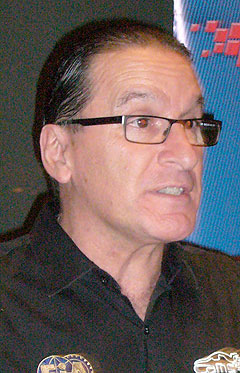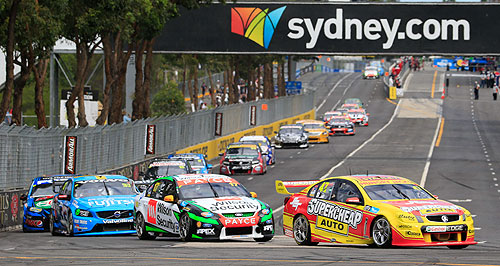News - General News - SportMotorsport wants recognitionMotor on: Motorsport's overseeing body in Australia wants more recognition and funding from the federal government. Australia needs a motorsport training Centre of Excellence and new tracks22 Apr 2015 By IAN PORTER THE Confederation of Australian Motor Sport (CAMS) and the performance and tuning industry are combining forces in a bid to get some recognition from the federal government for the $2.7 billion motor racing industry. The governing body of Australian car racing is aiming to win Government support for a centre of excellence training facility and a new race track that would serve the local sport and also expand the income already being generated from training Formula 1 Grand Prix organisers from around the world. The CAMS drive for more recognition has coincided with a similar campaign launched by the Performance Racing and Tuning Council (PRTC), which is part of the Australian Automotive Aftermarket Association (AAAA). The two campaigns have been harnessed in a bid to demonstrate the importance of performance tuning and motorsport to the community. The PRTC comprises 221 companies, large and small, which make a living manufacturing, distributing and selling parts and services to motorsport competitors. More than 40 per cent are manufacturers and almost 50 per cent of them export. The PRTC believes its members could significantly increase their turnover, especially their export business, if they could secure some government assistance for the research and development operations and their export efforts.  Left: Confederation of Australian Motor Sport chief executive Eugene Arocca.Under the leadership of the former chief executive of the Collingwood and North Melbourne football clubs, Eugene Arocca, CAMS is determined to make sure politicians understand the economic impact of motorsport. Left: Confederation of Australian Motor Sport chief executive Eugene Arocca.Under the leadership of the former chief executive of the Collingwood and North Melbourne football clubs, Eugene Arocca, CAMS is determined to make sure politicians understand the economic impact of motorsport.An Ernst and Young survey in 2013 showed that CAMS-affiliated motorsport created a direct value added of $1.2 billion a year and a direct industry output – which includes travel, accommodation and other costs – of $2.7 billion a year. Mr Arocca also wants to lure away some of the money that governments are pouring into other sports, including Australian rules football, many of which make almost no economic contribution. “We got the impression from government that they didn’t rate us,” Mr Arocca told a meeting at the Australian Auto Aftermarket Expo in Melbourne. “It’s all about swimming. They get $9 million a year. Basketball and netball, they are all very wonderful sports, but when motorsport receives the 38th lowest level of funding out of 40 sports, something’s wrong. “We have 150,000 people participate, competing and being involved, $2.7 billion direct industry output. “If we take in indirect output, it’s estimated at nearly $7 billion a year. We have 16,300 jobs in the industry. “When you add the performance and tuning automotive aftermarket, it’s $11 billion in output, 40,000 employees, $800 million in exports. “We have got to start being heard.” Mr Arocca has already spoken with several councils around the country and has found a growing awareness of the value of motorsport, the majority of which happens outside the major metropolitan areas. “There has got to be a region in Australia where there is an opportunity to build a national or international level track and park behind it a motorsport and automotive precinct. “The Silverstone one is mind blowing. Why couldn’t we have a vision of creating, in a major regional city, an automotive and motorsport park?“We are in discussion with councils around the country who are looking to acquire 1000 hectares, believe it or not. “Mind you, they haven’t got the money to build the track, but they are starting to think about the opportunities regionally, that a V8 event or a Moto GP with an automotive park behind it and Centre of Excellence around the corner could actually put a regional area on the map. “Trust me, there are some councils out there that are listening. They are getting a little tired of the AFL story, the AFL coming up three times a year, 15,000 people go to a game in a regional city and then they go home. “To actually have a living, breathing automotive industry sitting in a major regional area of our country has to appeal to government.” Mr Arocca said CAMS already pulls in more export income than the AFL yet, over the past 10 years, the AFL had received $2.4 billion in funding for facilities from government while CAMS received virtually nothing. While there were 334 track and venues across the country, none had been built in the last 20 years and virtually all of them were privately owned, which “has a significant impact on the way you can operate the industry”. Mr Arocca said a Centre of Excellence located on a racetrack would enable CAMS to exploit its position as a world-ranked trainer in motorsport operations. “Every year for the last five years CAMS has sent between 20 and 100 officials overseas to train other countries on how to put on motorsport events. “The Russian GP was essentially a CAMS production and we were paid for that exercise. We got more for that than we received from the federal government. Mr Arocca said Australia was well placed to become the regional centre of motorsport and motorsport training as the sport grows quickly in countries like China, India and across the Asia-Pacific. “In 2011 we went to Korea and shipped out 80 officials. We also exported talent to Russia and Singapore. “We taught Singapore how to put the race on. There are seven or eight countries, Bahrain is another, where we have taught them, where we have taken a group of 20 or 50 or 70 people – everyone from race control clerk of course through to the flaggies – taken them onto the course about a month out from the race.” Mr Arocca said a Centre of Excellence would allow CAMS to bring the training in-house to Australia, with overseas motor racing officials coming to Australia to train. He envisages a university or, more likely, a TAFE institution being associated with the Centre of Excellence so that apprentices and engineering students can get hands-on training, and mentoring from professionals, in their chosen fields. “We are a big supporter of the Formula SAE competition: there’s about 35 universities, 400-500 kids involved each year. “Wouldn’t it be great to have a centre where they knew they can get the training, working through a university or a TAFE? “We want to be able to teach race kids about sponsorship and media, we want to teach young apprentices how to be involved in motorsport.” The convenor of the AAAA’s Performance Tuning and Racing Council, Robert Johnson, said there was a strong case for supporting the parts manufacturers who will survive the closure of car manufacturing, especially the performance and tuning manufacturers. Presenting the results of the 2014 survey of PTRC members, he said there had been a marked improvement in confidence, with 48 per cent of respondents optimistic about the outlook for the industry, compared with 31 per cent in the last survey, taken in 2009. “Our members are already running export programs. They participate in major shows overseas like the SEMA (Specialty Equipment Manufacturers Association) show in the US. “These are markets we are active in with very little government assistance. “So, if there was some government assistance to free up some of that burden on the small manufacturers, they could lift their export business significantly.” Mr Johnson said that, apart from export and marketing assistance, the manufacturers in the performance sector would also benefit from research and development grants to help ease the burden of investment in new products. He said 43 per cent of the 221 members in the PRTC were manufacturing components, tools or equipment. Another 28 per cent of respondents said their business focused on workshop and tuning work, up from 18 per cent in 2009. “This growth reflects the strength of the motorsport industry itself. If there are growing numbers of people competing in motorsport events, as shown by the CAMS study, then there will be more demand for performance improvement products and tuning work.”  |
Click to shareGeneral News articlesResearch General News Motor industry news |














Facebook Twitter Instagram